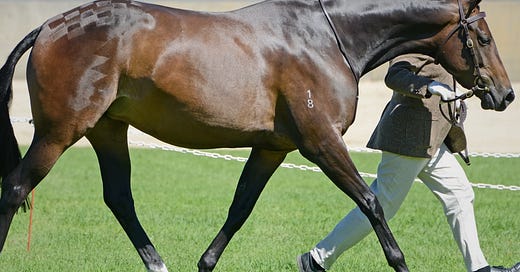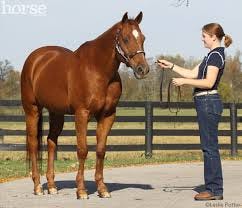In a previous post, I stated
Simply put, we treat our horses as naturally as possible, with routine, consistency and respect. They gain confidence through us, and are confident in us.Confidence allows them to feel safe, and therefore they can focus on the job we ask of them.
When handling a horse, especially a stallion at a show, it is important to know them very well and to make minute adjustments and signals based on your awareness before they do anything untoward.
In most cases, where a horse misbehaves, the handler has not foreseen the problem so makes corrections too late. By then it is obvious there is a difficulty and the horse is anxious or confused.
So what are the nuances which make a horse reliable at a show?
What do we do at home and then foster at the show?
In this post I talked about starting out with the right temperament. Genetics plays a huge role, however, the rest is about calmness and consistency in your training.
Let me talk about one area of consistency which plays a huge part in this, and that is
Teaching a horse to stand still.
There are two positions in which the horse MUST stand still. No exceptions.
Formal position
This is when you are in a class, or having your horse’s photo taken - anywhere you want him to be still without moving his feet or resting a leg. The only thing he is allowed to move is his head, neck and tail! You are standing out the front, (but not directly in front.) You are facing the judge.
Without turning your feet, you can see down the line up as well as what your horse is doing. By swivelling your feet, you can check what is going on behind you, if needed. Therefore you are never out of position.
Informal position
This is any position you typically stand in when you are chatting to someone else, or doing routine tasks, like grooming, rugging etc.
You can stand by his shoulder, or move around him as required but you don’t stand out in front! You may have him tied up, such as in a wash bay, or eating hay. The point is, although he is still not to move his feet, he can be resting a leg standing informally too.
With any movement out of line, put him back into the original position.
It is important that you also have a signal which allows him to move again - that might be as simple as “walk on.”
If not, how does he know when it is OK to move, since you have been telling him not to???
Do’s and Don’ts -
Q: What is wrong with this picture?
A: It shows neither one position or the other.
You must clearly make up your mind if you are formal or informal every time you are with your horse. One frequently sees people in this ambiguous position in their class. The horse has no indication as to what he should be doing.
Note: you cannot see what the horse is doing in this position. If he should move at all, you won’t see it until the horse has moved way out of line, and you are likely to over- correct him, or worse, walk around in a circle. Never reposition your horse by circling in a class.
(The horse which doesn’t want to stand still will quickly learn that if it gets out of position, you will take it for a little walk around.)
Formal position is trained with a whip.
Carry a whip with you everywhere you go (leading) and at the show. Stand out the front - that is your cue.
You train your horse to move on the forehand with your whip.
Decide if it responds to a light touch or simply pointing near its side. You teach it to move across only one step at a time - stop - now another step, until it is back in position.
Always back in position. And again each time it moves, back into position. Stop. Repeat, repeat, repeat - at home!
If he moves forward 2 steps, step him back 2 steps with the knob of the whip (not the bridle) until you can do the same by simply pointing. (If in informal position, it might be with the point of your brush.)
Each time he moves out of position, you can do it slightly more forcefully until he takes notice.
Do this daily until it gets the idea, that every time you stand in formal position, it adopts the “do not move” posture.
Then you can start practicing without the whip.
We like to take our whip in class, to use it as a signal to prick ears. If we see our horse about to move, we do the whip pointing “thing.” It stops him in his tracks and reminds him not to move at this moment.
This is done in one fluid motion so it is rarely noticed by onlookers.
What to do at the show
When handling a horse, especially a stallion at a show, it is important to know it very well and to make minute adjustments and signals based on your awareness before they do anything untoward.
This is the nuance of having the horse stand still in his class, waiting. He knows what is expected of him because it has been practiced at home. He is fluent in it.
He knows that he is safe by following the guidance of his handler and ignoring everything else. He is certainly aware of all the sights and sounds, but he doesn’t spook at them or get upset, because the handler’s expectations give him the confidence.
In most cases, when a horse misbehaves, the handler has not foreseen the problem so makes corrections too late. By then it is obvious there is a difficulty as the horse becomes anxious or confused.
Most of this confusion starts at home where the person is inconsistent, either through lack of awareness, or inattention (lack of focus)
• by not requiring the horse to stand still at all
• standing in the wrong position
• forgetting when chatting to someone, that you still want him to stand still
• not noticing the horse which “creeps” for instance, or the one who pushes you out of position with his shoulder.
• or you may do all of these, but never quite get there, because you are too late in your responses.
Keep reading with a 7-day free trial
Subscribe to Reflections on 50+ Years of Horse Breeding to keep reading this post and get 7 days of free access to the full post archives.








